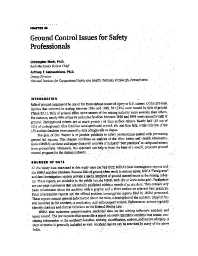Mining Publication: Ground Control Issues for Safety Professionals
Original creation date: November 2001
Falls of ground continue to be one of the most serious causes of injury to U.S. miners. Of the 256 fatal injuries that occurred in mining between 1996 and 1998, 59 (23%) were caused by falls of round (Table 23.1). Falls of ground affect some sectors of the mining industry more severely than others. For instance, nearly 40% of the 98 coal mine fatalities between 1996 and 1998 were caused by falls of ground. Underground miners are at much greater risk than surface miners. Nearly half (45 out of 101) of underground mine fatalities were attributed to roof, rib, and face falls, while only 6% of the 155 surface fatalities were caused by falls of highwalls or slopes. The goal of this chapter is to provide guidance to safety professionals tasked with preventing ground fall injuries. This chapter combines an analysis of the Mine Safety and Health Administration's (MSHA) accident and injury data with a survey of industry "best practices" to safeguard miners from ground falls. Ultimately, this approach can help to form the basis of a sound, proactive ground control program for the mining industry.
Authors: C Mark, AT Iannacchione
Book Chapter - November 2001
NIOSHTIC2 Number: 20021381
Mine Health and Safety Management, 2001, Nov M. Karmis, Littleton, Colorado: Society for Mining, Metallurgy, and Exploration, Inc., :347-367
See Also
- 60 Years of Rockbursting in the Coeur D'Alene District of Northern Idaho, USA: Lessons Learned and Remaining Issues
- Analysis of Multiple Seam Stability
- Calibration and Verification of Longwall Stress Models
- Determination of Sound Exposures (DOSES): Software Manual and Implementation Guide
- Global Trends in Coal Mine Horizontal Stress Measurements
- Haulage Truck Dump Site Safety: An Examination of Reported Injuries
- Proceedings: New Technology for Ground Control in Multiple-seam Mining
- Rock Bursting and Seismicity During Ramp Development, Lucky Friday Mine, Mullan, Idaho
- Task Analysis
- Technology News 536 - NIOSH Develops New Software to Analyze and Reduce Noise Exposure
- Page last reviewed: 7/14/2015
- Page last updated: 7/14/2015
- Content source: National Institute for Occupational Safety and Health, Mining Program


 ShareCompartir
ShareCompartir
